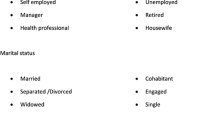Abstract
Purpose
About 40–50 % of cancer patients use complementary and alternative medicine (CAM). Women, and especially those with gynecological cancers, are more active in this field than men. The goal of our study was to estimate the likelihood of CAM use and the likelihood of interactions of CAM with cancer therapy in the setting of a gynecological outpatient clinic at a German Comprehensive Cancer Center (CCC).
Methods
One hundred consecutive gynecological outdoor patients of the CCC in Frankfurt am Main in Germany were interviewed with a standardized questionnaire on CAM use. An investigation on potential interactions was done by matching a scientific database systematically.
Results
Sixty-nine of the interviewed 100 women received chemotherapy, 23 endocrine therapy and 41 monoclonal antibodies. In total, 64 % used CAM, 48 % used at least one substance-bound CAM. In 17 out of those 48 cases (35 %), interactions were unlikely, whereas they were probable in 14 patients (29 %). Thus, a third of all patients in this study were in danger of interactions. More than half of all CAM users and three quarters of users of substance-bound CAM are at risk of interactions. This number is independent of whether the patient is taking chemotherapy, endocrine therapy or antibodies.
Conclusions
The frequency of CAM use we found is in line with international data from CCCs in the USA. To our knowledge, this is the first study publishing data on the frequency of potential interactions. Thus, an initiative to protect women from the dangers of uncontrolled CAM use is urgently needed. In the discussion, we propose a concept of how to achieve this aim.


Similar content being viewed by others
References
Cassileth BR, Lucarelli CD (2003) Herb-drug interactions in oncology. Brian C Decker, London
Dy GK, Bekele L, Hanson LJ, Furth A, Mandrekar S, Sloan JA, Adjei AA (2004) Complementary and alternative medicine use by patients enrolled onto phase I clinical trials. JCO 22(23):4810–4815
Eschiti VS (2007) Lesson from comparison of CAM use by women with female-specific cancers to others: it’s time to focus on interaction risks with CAM therapies. Integr Cancer Ther 6(4):313–344
Henderson JW, Donatelle RJ (2003) The relationship between cancer locus of control and complementary and alternative medicine use by women diagnosed with breast cancer. Psychooncology 12(1):59–67
Henderson JW, Donatelle RJ (2004) Complementary and alternative medicine use by women after completion of allopathic treatment for breast cancer. Altern Ther Health Med 10(1):52–57
Hlubocky FJ, Ratain MJ, Wen M, Daugherty CK (2007) Complementary and alternative medicine among advanced cancer patients enrolled on phase I trials: a study of prognosis, quality of life and preferences for decision making. JCO 25:548–554
Horneber M, Bueschel G, Dennert G, Less D, Ritter E, Zwahlen M (2011) How many cancer patients use complementary and alternative medicine: a systematic review and metaanalysis. Integr Cancer Ther [Epub ahead of print] PMID: 22019489
Micke O, Bruns F, Glatzel M, Schönekaes K, Micke P, Mücke R, Büntzel J (2009) Predictive factors for the use of complementary and alternative medicine (CAM) in radiation oncology. Eur J Integr Med 1:22–30
Molassiotis A, Scott JA, Kearney N, Pud D, Magri M, Selvekerova S, Bruyns I, Fernadez-Ortega P, Panteli V, Margulies A, Gudmundsdottir G, Milovics L, Ozden G, Platin N, Patiraki E (2006a) Complementary and alternative medicine use in breast cancer patients in Europe. Support Care Cancer 14(3):260–267
Molassiotis A, Browall M, Milovics L, Panteli V, Patiraki E, Fernandez-Ortega P (2006b) Complementary and alternative medicine use in patients with gynecological cancers in Europe. Int J Gynecol Cancer 16(Suppl 1):219–224
Naing A, Stephen SK, Frenkel M, Chandhasin C, Hong DS, Lei X, Falchook G, Wheler JJ, Fu S, Kurzrock R (2011) Prevalence of complementary medicine use in a phase 1 clinical trials program: the MD Anderson Cancer Center Experience. Cancer 117(22):5142–5150
Richardson MA, Sanders T, Palmer JL, Greisinger A, Singletary SE (2000) Complementary/alternative medicine use in a comprehensive cancer center and the implications for oncology. J Clin Oncol 18(13):2505–2514
Robinson A, McGrail MR (2004) Disclosure of CAM use to medical practitioners: a review of qualitative and quantitative studies. Complement Ther Med 12(2-3):90–98
Saxe GA, Madlensky L, Kealey S, Wu DP, Freeman KL, Pierce JP (2008) Disclosure to physicians of CAM use by breast cancer patients: findings from the women‘s healthy eating and living study. Integr Cancer Ther 7(3):122–127
Sparber A, Bauer L, Curt G, Eisenberg D, Levin T, Parks S, Steinberg SM, Wootton J (2000) Use of complementary medicine by adult patients participating in cancer clinical trials. Oncol Nurs Forum 27(4):623–630
Velicer CM, Ulrich CM (2008) Vitamin and mineral supplement use among US adults after cancer diagnosis: a systematic review. J Clin Oncol 26(4):665–673
Conflict of interest
We declare that we have no conflict of interest.
Author information
Authors and Affiliations
Corresponding author
Additional information
This study was conducted on behalf of PRIO—working group Prevention and Integrative Oncology of the German Cancer Society.
Electronic supplementary material
Below is the link to the electronic supplementary material.
Rights and permissions
About this article
Cite this article
Zeller, T., Muenstedt, K., Stoll, C. et al. Potential interactions of complementary and alternative medicine with cancer therapy in outpatients with gynecological cancer in a comprehensive cancer center. J Cancer Res Clin Oncol 139, 357–365 (2013). https://doi.org/10.1007/s00432-012-1336-6
Received:
Accepted:
Published:
Issue Date:
DOI: https://doi.org/10.1007/s00432-012-1336-6




